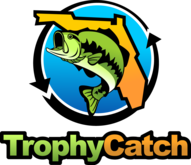 The post-spawn dog days of summer slowed TrophyCatch submissions a little, but it was still clear that even the middle of summer can be a great time to go fishing in Florida, the Fishing Capital of the World! We have now received 2,100 approved Season 4 submissions at the end of August 2016, which surpasses the 1,744 bass that were submitted during Season 3! This current number included 1,768 Lunker Club bass (8 - 9.9 pounds), 325 Trophy Club bass (10 - 12.9 pounds), and 7 Hall of Fame bass (13+ pounds). Don't wait until you catch a qualifying bass -- register for TrophyCatch now to be eligible for the Phoenix Boats bass boat giveaway which will take place in December!
|
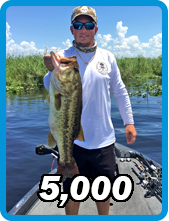 Season 4 submission numbers are already impressive compared to previous years, but an even more amazing statistic was the 5,000th approved bass submission for TrophyCatch since the program was launched in October 2012! That also means 5,000 trophy bass are still swimming in Florida! Thanks to all our participants for helping us reach this milestone, and to our valued partners like Bass Pro Shops, Mercury Marine, Phoenix Boats and others for making the catch-and-release of trophy bass all the more rewarding!!
|
Mark your calendar for October 15, 2016! That is the deadline for submitting your Season 4 TrophyCatch bass to receive prizing. Season 4 began October 1, 2015 and ended September 30, 2016. So be sure to get any remaining submissions in before the deadline! |
|
 |
Registering for TrophyCatch is free, easy and will automatically enter you in a drawing for the Phoenix Boats TrophyCatch bass boat which will be given away in December -- no catch necessary! |
|
 |
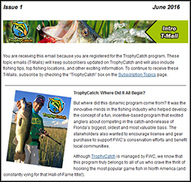 The Florida Freshwater Angler includes TrophyCatch news on a quarterly basis, but in order to provide more frequent program updates and related information, FWC is introducing the TrophyCatch T-Mail! These short topic emails ("T-Mails") will keep subscribers updated on TrophyCatch on a monthly basis and will also include related fishing tips, top fishing locations and other exciting bass-related information. Subscribe now by checking the
"TrophyCatch” box on the Subscription Topics page under "Freshwater Fishing"! Note that if you have already registered for TrophyCatch or Big Catch you are already set up to receive the TrophyCatch T-Mail.
|
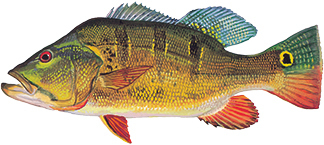 Size: The current certified state record is 9.08 pounds, although larger peacock bass have been documented in Florida. The Big Catch minimum qualifying sizes are 4.00 pounds or 18 inches for adults, and 3.00 pounds or 13 inches for youth (BigCatchFlorida.com).
Origin and range: Amazon River Basin in South America. The butterfly peacock is the only legally introduced exotic fish to become established in Florida, and were stocked only after many years of scientific research. These fish were introduced to increase predation on illegally introduced and abundant exotic forage fishes, especially the African spotted tilapia, as well as to enhance freshwater sportfishing opportunities in the metropolitan Miami-Ft. Lauderdale area. About 20,000 fingerlings were stocked by the FWC in eleven south Florida canals between 1984 and 1987. These fish were protected by law until 1989 when their population was deemed large enough to support harvest. Butterfly peacock in Florida range as far north as Palm Beach County..
Identification and similar species: This fish is not a true bass, but is related
instead to other cichlids such as the Oscar and spotted tilapia. This
bright, gold-colored fish is hard to mistake. The lower fins are bright
red, and there are usually three vertical black bars on the body that are more
pronounced in younger fish. Unlike the familiar largemouth bass, bigger
butterfly peacocks will most likely be males rather than females. Male
peacocks can also be distinguished by a pronounced hump on the forehead
during the breeding season.
Angling qualities: This highly desirable gamefish is well-known for its aggressive strikes, strong fight and acrobatic leaps. Highly piscivorous (eating other fishes), this fish will fall to most minnow imitations such as Rat-L-Traps and Rapalas. Small jigs and various topwater lures are other favorites. The "big lure, big fish" axiom does not hold true here -- stick with smaller lures up to 3 inches. Peacocks also prefer a very rapid retrieve. When using bait, live shiners are the top choice.
Where to catch them: Butterfly peacock thrive in south Florida's canal systems, and detailed canal maps are available at the Miami-Dade, Broward & Palm Beach Canals Fishing Forecast. The best canals for peacock bass, based on the most recent surveys, include the Tamiami (C-4), Cutler Drain (C-100) and Snake Creek (C-9) canals. The Boynton (C-16) and West Palm Beach (C-51) canals are also good, but be aware that extreme cold can cause exotic fish kills that have greatly reduced peacock bass numbers here in the past.
Butterfly peacock bass illustration by Duane Raver, Jr.
|
You probably think that you're very different from the fish you pursue. They live in lakes; you live on land. You breathe air; fish breathe water. And you face each other from very different ends of a fishing rod! But when you take a closer look on an anatomical level, anglers and fish are more similar than they are different. Here are some of the internal features of the fish, most of which they share with us. A largemouth bass destined for the frying pan makes an excellent
specimen because this species is large enough for easy examination. For
anglers brave enough to do some investigating while filleting their
next fish, a fascinating experience awaits!
(Largemouth Bass illustration modified from Duane Raver, Jr.)
Lateral Line -- One of the fish’s primary sense organs; detects
underwater vibrations and is capable of determining the location of
their source.
Muscle -- Provides movement and locomotion. This is the part of the fish
that is usually eaten, and composes the fillet of the fish.
Kidney -- Filters liquid waste materials from the blood. Extremely important in
regulating water and salt concentrations within the fish’s body,
allowing certain fish species to exist in freshwater or saltwater, and
in some cases (such as snook or tarpon) both.
Pyloric Caeca -- This organ with fingerlike projections is located near
the junction of the stomach and the intestines. It secretes enzymes that aid in
digestion.
Spinal Cord -- Connects the brain to the rest of the body and relays
sensory information from the body to the brain, as well as instructions
from the brain to the rest of the body.
Spine -- The primary structural framework upon which the fish’s body is built; connects to the skull at the front of the fish and to the tail at the rear.
Brain -- The control center of the fish. All sensory information is processed here. A bass brain is about the size of a shelled peanut!
Swim (or Air) Bladder -- A hollow, gas-filled balance organ that allows a fish to conserve energy by maintaining neutral buoyancy (suspending) in water.
Eggs -- In adult female bass, the bright orange
mass of eggs is unmistakable during the spawning season, but is still
usually identifiable at other times of the year. The male organs, which
produce milt for fertilizing the eggs, are much smaller and white but
found in the same general location.
Stomach and Intestines -- Break down (digest) food and absorb nutrients. Fish such as bass that are piscivorous (eat other fish) have fairly short intestines because such food is easy to chemically break down. Fish such as tilapia that are herbivorous (eat plants) require longer intestines because plant matter is usually tough and fibrous and more difficult to break down.
Vent -- The site of waste elimination from the fish’s body.
Liver -- Assists in digestion by secreting enzymes that break down fats. Also important in maintaining proper blood chemistry and waste excretion.
Heart -- Circulates blood throughout the body. Oxygen and digested nutrients are delivered to the cells of various organs through the blood, and the blood transports waste products from the cells to the kidneys and liver for elimination.
Gills -- Allow a fish to breathe underwater. These are very delicate and should not be touched if the fish is to be released.
If many of these terms sound familiar to you, you should have a better appreciation for the kinship you share with your fellow creature, the fish!
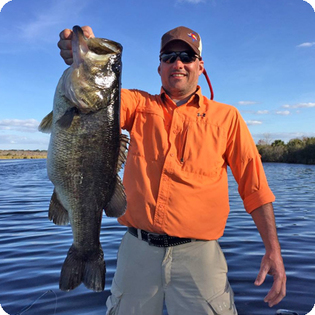 Size: 46,000 acres.
Location: Putnam, Volusia, Lake and Marion counties.
Description: Lake George is Florida’s second largest
freshwater lake. Lake George is known as a perennial hot spot for a variety of
fish species. Although most of the lake is 8-10 feet deep, shallow flats along
the perimeter of the lake support healthy stands of submersed aquatic vegetation
such as eelgrass, southern naiad, and hydrilla that may extend as far as 700
yards from the shoreline. The submersed vegetation provides excellent habitat
for an abundance of game and non-game fish. The flats in the southwest part of
the lake, near the mouth of Silver Glen Springs, are a well-known hotspot for largemouth bass in the springtime. Also in the springtime, sunshine bass can be
caught along the jetties on the south end of the lake, where the St. John’s
River enters the lake. Occasionally, anglers may have an exciting encounter
with a striped bass while targeting sunshine bass in Lake George. Although the
two species look similar, striped bass can tip the scale at over 30 pounds! In
late spring through summer, Lake George has excellent fishing for bluegill and redear sunfish. Bluegill and redear spawn in colonies, and once an active
colony is located, anglers can catch dozens of quality-sized fish in one
outing. Lake George supports a good crappie population, but few anglers choose
to target them in the lake. Anglers can find good numbers of white and channel catfish in the vast open waters of Lake George. Anglers would be well
advised to always keep an eye on the weather. Windy weather
associated with cold fronts and summertime thunderstorms can make for unsafe
boating conditions, so stay safe for an enjoyable Lake George outing!
Public access to Lake George can be somewhat limited.
Private boat ramps open to the public (fees may be required) are located at
M-bar Marina and Pine Island Resort. A shallow draft public boat ramp is
located on the south end of the lake, off Blue Creek Lodge Road. Many boaters
choose to access the lake via the St. John’s River public boat ramp in Astor,
or a variety of private fish camps in Astor or Georgetown. For more site information please call our Northeast Region Office at 352-732-1225.
|
To contact the Florida Freshwater Angler, email John Cimbaro.
|